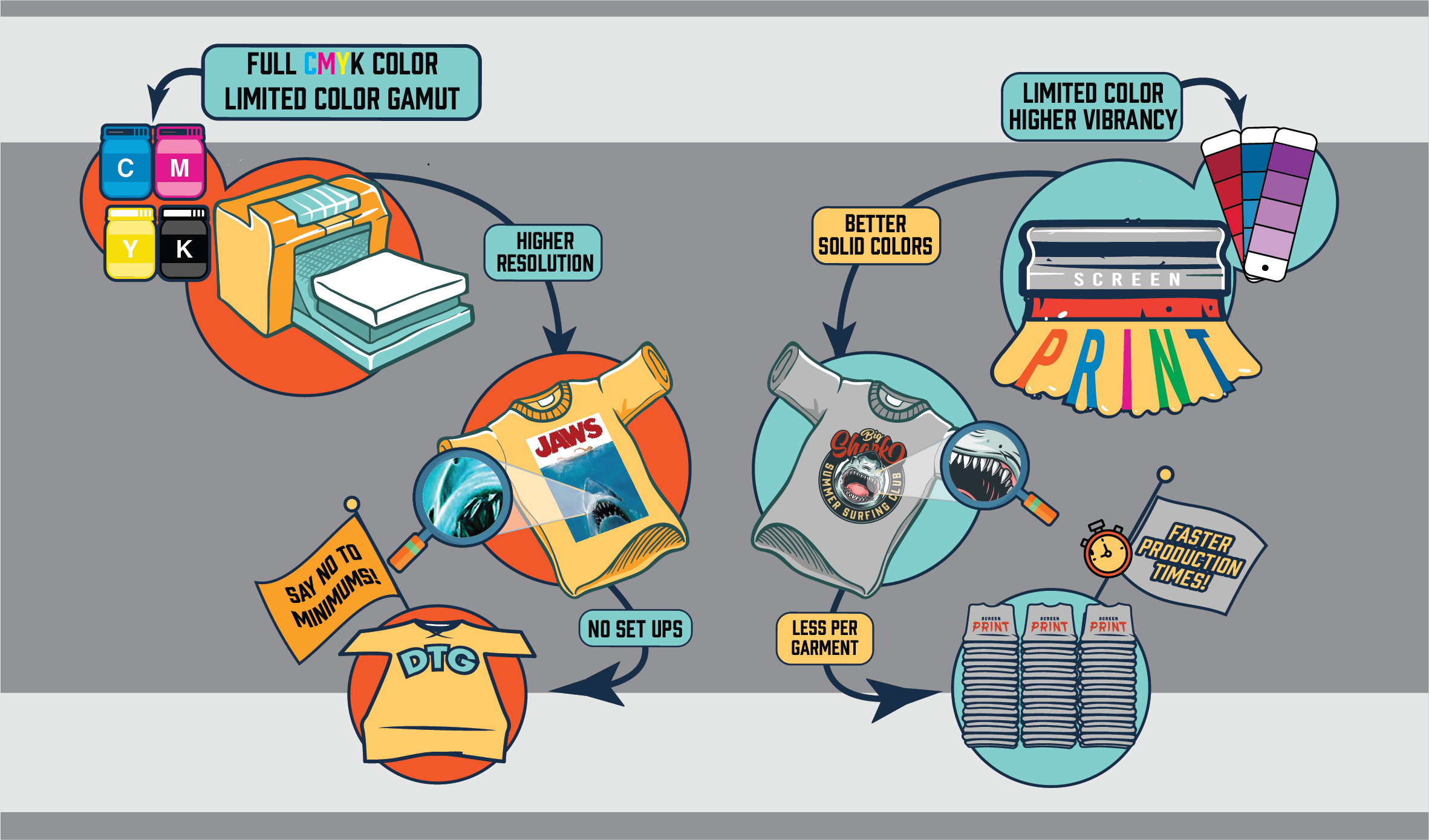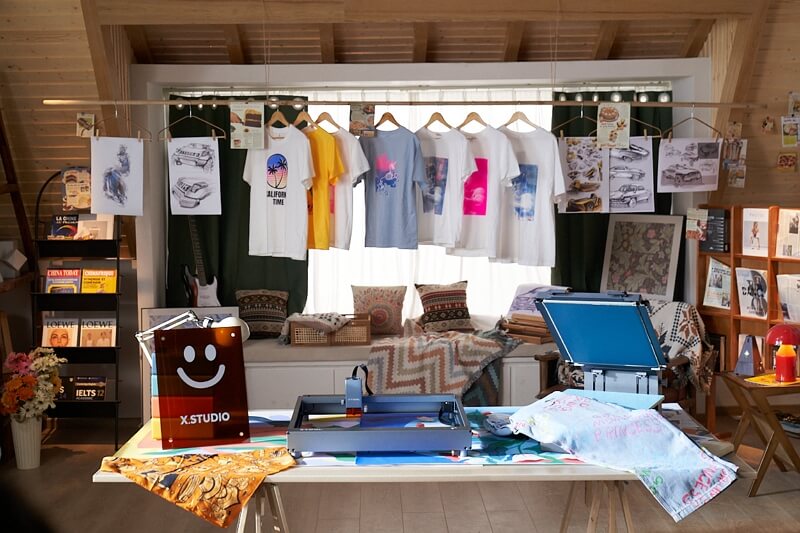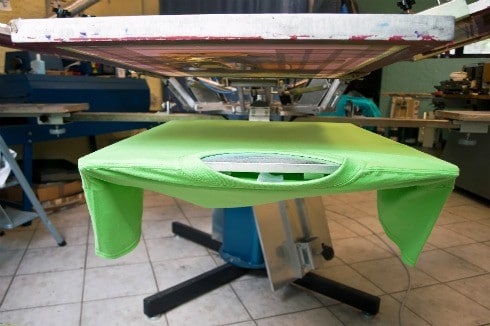3 Easy Facts About Tx Tees Explained
3 Easy Facts About Tx Tees Explained
Blog Article
An Unbiased View of Tx Tees
Table of ContentsMore About Tx TeesThe Tx Tees IdeasSome Known Questions About Tx Tees.3 Easy Facts About Tx Tees ShownThe 9-Minute Rule for Tx TeesThe Tx Tees IdeasGetting My Tx Tees To Work
That brings your total amount to about $1,900 prior to tax and delivery. Build up other costs, like the variety of energies it takes to run the store and the expense of ink and emulsion per layout. screen printer. Take the print below for instance. This is a one-color photo, so the price of ink per tee shirt is roughly 20 cents.The solution ought to only be a few cents given that you 'd just need to layer one display for this job. Generally, printers try to make up to 45% revenue on a print task.

With DTF, you can publish a handful of shirts, or just one. Utilize the same calculator as the area over to compute just how much earnings you 'd use DTF transfers. Contrast the expenses and profits to whichever approach speaks finest to your setup and procedure. Both display printing and DTF have their specific niches worldwide.
Not known Incorrect Statements About Tx Tees
The best means to know? Ask about and see what printing shop like yours are doing. custom screen printing. Try both out and see which you like far better
When you're picking what sort of printing approach to utilize for printing your artwork designs on your garments, it is very important that you understand the differences between these two techniques so you can optimize results while lessening prices. Display printing is one of the most commonly used technique for printing designs on textiles.
DTG printing is likewise referred to as area or direct to garment printing since it publishes only what is required rather than making a display as display printers do. https://tx-tees-45701767.hubspotpagebuilder.com/blog/txtees02. Screen printing works by screen filler squeegee display printing ink display mesh display, after that transferring the picture to garment making use of warm and/or pressure
The DTG printer uses special dye-sublimation inks that are applied into a pre-designed image by an electronic printing system. The inks end up being part of the fabric, permitting dynamic colors and phenomenal information. It's likewise called place or direct to garment printing because it publishes only what is required as opposed to making a screen as display printers do.
More About Tx Tees
It's much quicker - you can publish a fullcolor image in mins, as opposed to hours for screen printing. Second, there's no established up time or costs entailed - you can publish any layout you such as, without needing to create a screen first. Third, there's no waste - because display printers display print one design at once, they have to screen each shade independently.
The paper is really expensive and can just be made use of when. Once it's printed on, it needs to be discarded. - The first purchase cost is reduced than the in advance investment of DTG printers- You can print multi-color styles one display at a time rather than having to publish each shade individually like DTG printing.

The Ultimate Guide To Tx Tees
Instead of using screen mesh as display printers do, color sublimation printers make use of laser technology to transfer your photos onto garments or paper. A warm process moves the color from its solid-state directly into the gas phase which subsequently merges it onto fabric substrates when they are rapidly heated up to high temperature levels under high stress.
Sublimation printing is eco-friendly. It uses less water than screenprinting, and because it does not include using hazardous solvents, it's risk-free for all types of clothing. The dye sublimation inks are also unsmelling when cured, unlike screen printers that utilize hazardous chemicals throughout the display printing process that leave behind an undesirable smell.
They additionally save cash on pricey equipment like exposure units given that dye sublimation printers don't require a UV exposure system or a flash remedy stove that is typically made use of in screen printing (custom t-shirt design). What is straight to garment printing (DTG Printing)? DTG printing is a digital screenprinting process that publishes directly onto fabric utilizing specialized inkjet printers
All about Tx Tees
DTG printing supplies numerous advantages over standard screenprinting, including the capacity to print photo high quality images, higher shade vibrancy, and the ability to publish designs on darker textiles. DTG printers work by warming the textile ink till it turns right into a gas. The gas then penetrates the material, bonding with the fibers to develop a long-term print.

Screen printers just prepare their screen then start publishing up until they lack item or ink.- There is a vast array of knowledgeable screen printers all over the globe, which can be helpful for newbies. - It's a slower procedure - screen printers usually have to wait for the ink to completely dry prior to they can print the following shade- Display printers require manual labor, so there's a greater understanding contour and it takes longer to produce a top quality design- Display printing isn't as precise as DTG printing, so you may obtain some "blood loss" of colors from one component of the picture onto another otherwise done appropriately.
The Facts About Tx Tees Uncovered
Nonetheless, instead of utilizing screen mesh as screen printers do, color sublimation printers use laser modern technology to transfer your pictures onto garments or paper. A heat process moves the dye from its solid-state directly right into the gas phase which in turn merges it onto fabric substratums when they are swiftly heated up to high temperature levels under high pressure.
Sublimation printing is green. It uses less water than screenprinting, and due to the fact that it doesn't include using harmful solvents, it's risk-free for all kinds of apparel. The dye sublimation inks are likewise unsmelling when cured, unlike screen printers that utilize unsafe chemicals during the screen printing process that leave behind an undesirable smell.
They additionally conserve money on costly devices like direct exposure devices given that color sublimation printers don't require a UV exposure system or a flash treatment stove that is generally used in screen printing. What is direct to garment printing (DTG Printing)? DTG printing is a digital screenprinting process that prints directly onto material utilizing specialized inkjet printers.
Tx Tees Can Be Fun For Anyone
DTG printing uses numerous benefits over traditional screenprinting, including the capacity to publish photographic high quality images, greater color vibrancy, and the ability to publish layouts on darker materials. DTG printers work by warming the fabric ink up until it develops into a gas. The gas then penetrates the material, bonding with the fibers to create an irreversible print.
Report this page